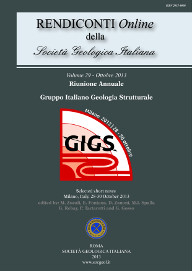
A preliminary tectonic model for interpreting the Peloritani Alpine metamorphism
Roberta Somma (a) & Ivan Martin-Rojas (b)
(a) Dipartimento di Scienze dell'Ambiente, Sicurezza, Territorio, Alimenti e Salute (S.A.S.T.A.S.), Università degli Studi di Messina, Viale F. Stagno D'Alcontres, 31, Sant'Agata di Messina, 98166 Messina, Italy. Telephone: 090/6765180. E-mail: rsomma@unime.it
(b) Departamento de Ciencias de la Tierra y del Medio Ambiente, Universidad de Alicante, Ap. 99 03080 Alicante, Spain.
Volume: 29/2013
Pages: 169-172
Abstract
The Peloritani Chain (NE Sicily) is composed of different tectonic units, denoted from top to bottom: Aspromonte, Mela, Mandanici-Piraino, Ali-Montagnareale, Fondachelli, and Longi-Taormina Units. They are made up of Variscan crystalline basements and post-Variscan sedimentary covers, except the two structurally highest units that are formed only by crystalline rocks. Among the Peloritani units, only three of them were affected by Alpine metamorphism: the Ali-Montagnareale, Mandanici-Piraino, and Aspromonte Units. A multidisciplinary approach, considering jointly the paleogeographical distribution of post-Variscan covers, petrological and structural data, and geometric relationships between the three Alpine units, was used for interpreting the tectonic context in which Peloritani Alpine metamorphism occurred. From a paleogeographical standpoint, the Peloritani post-Variscan sedimentary covers were stretched along a passive continental margin of a microplate (the Mesomediterranean Microplate). Facies analysis suggests that the distribution of the original paleodomains along this rifted margin was, from the most proximal area to the most distal one, as follows: Mandanici-Piraino, Ali-Montagnareale, Fondachelli , and Longi-Taormina. From a tectono-metamorphic standpoint, the Ali-Montagnareale and Mandanici-Piraino Units, i.e. the units provided of a cover sedimented in the most proximal paleodomains, were affected by an Alpine metamorphism developed under the anchizone and greenschist facies conditions, respectively, whereas the Aspromonte Unit (devoid of post-Variscan cover) underwent an Alpine overprint developed under conditions ranging from the amphibolite to the greenschist facies. The tectonic model here described suggests that the Peloritani Alpine metamorphism formed in deep-seated shear zones developed under an orogenic wedge for underthrusting of the most proximal paleomargin of the Mesomediterranean Microplate.
Keywords
Alpine metamorphism, Mesomediterranean Microplate, paleogeography, Peloritani Mountains, Peloritani paleomargin
Get Full Text